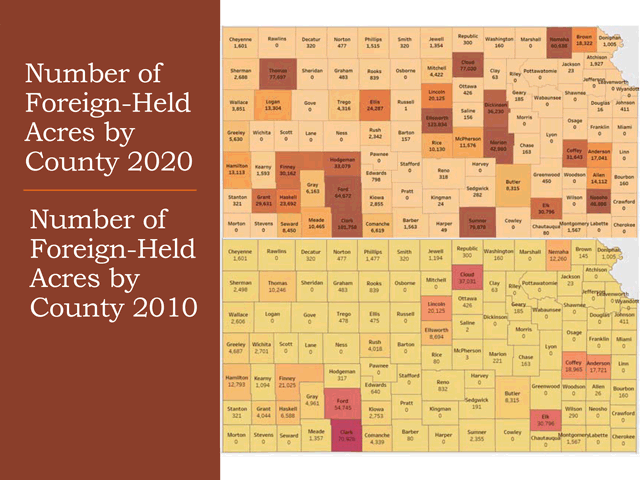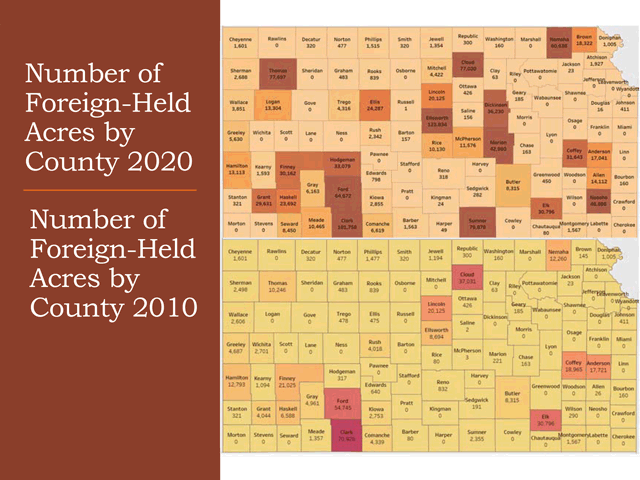Minding Ag's Business
Land Ownership and Foreign Investment Trends in Kansas
On April 5, Kansas State University economists Robin Reid and Allen Featherstone discussed trends in Kansas land ownership. It included initial findings of the annual Kansas Agricultural Land Values and Trends report, which hasn't been fully released yet, as well as an analysis of foreign ownership of agricultural interests and farmland.
Here are five takeaways from their webinar:
1) YES, LAND PRICES SURGED IN 2022
The Kansas Agricultural Land Values and Trends report is unique because it draws on transaction data, rather than surveys. By now, the story of 2022's meteoric rise in farmland values is well known. According to NASS survey data, Kansas farmland values climbed 24.5% in 2022, but KState Ag Economist Robin Reid said the sales data suggests dryland acres increased closer to 31% in price.
"One number for our state doesn't reflect anything but a trend," Reid said, adding that because of the wide variability in rainfall, water availability and soil quality, average numbers aren't the most informative in all situations. When data from the full report is released, she urges readers to look at the highs and lows for each county as well as the median sale price.
2) IRRIGATED LAND VALUE ANOMOLY
Reid's data showed that the average value of irrigated farmland in Kansas declined by 1.7% from the prior year, which she said seemed unexpected. There are four regions of the state that account for most irrigated acreage sales, but nearly 73% of total sales came from the southwestern region. While there were some eye-popping sales values, the data also reflected a lot of variability, so she checked with a few appraisers and land managers.
"What I can isolate it down to is there are irrigated sales occurring out there that just don't have the water anymore, and probably should have been classified as non-irrigated," she said. "Overall, I think the end of the story is there's a lot of variability, and the average itself didn't show that increase even though I know there's some very high-priced, irrigated ground. That's becoming more and more scarce to find out in the southwest."
3) OUT-OF-STATE OWNERSHIP INCREASED SINCE 2015
P[L1] D[0x0] M[300x250] OOP[F] ADUNIT[] T[]
After attending a number of auctions and discussing trends with real estate agents, Reid wanted to know if the data would back up a common observation that out-of-state buyers were primarily interested in land with hunting and recreational use.
Reid's sorted the data on parcels larger than 40 acres by the zip code where tax statements are sent. In 2015, she found that 15.5% of landowners lived outside Kansas, primarily in Texas, Colorado, Oklahoma, Nebraska and Missouri.
She used the same dataset for 2022, but it didn't include data for nine counties. She matched the data for 40 million acres between the two data sets to do a comparison of ownership changes between 2015 and 2022.
Of the 40 million acres in her sample, 25% had changed zip codes in seven years. Reid noted the zip code could change if the land was sold or inherited or if the owner moved. In the 2015 data set, 71% of the land was owned by Kansans. By 2022, that number declined to 68%.
"I looked at what type of ground this is, and it really did support the hypothesis that this is primarily pasture ground or ground that has hunting potential," she said.
4) GROWING CONCERNS ABOUT CHINESE OWNERSHIP
Featherstone said Fufeng Group's project to build a wet corn mill in North Dakota ignited a conversation about the risks of foreign ownership. You can read DTN's coverage of the corn mill here: https://www.dtnpf.com/… and here: https://www.dtnpf.com/….
"This has gotten a lot of political play," Featherstone said. "The Kansas legislature has debated some laws with regards to ownership. Whether anything passes or not, it will be interesting to see."
But he points out that it's hardly the first Chinese investment in U.S. agriculture, and nowhere near the largest. In 2013, China's W.H. Group purchased Smithfield Foods for $4.7 billion, acquiring its hog genetics, intellectual property and about 146,000 acres in the process. China National Chemical Corporation purchased Syngenta in 2017 for $43 billion, which included 16 farm sites in the United States.
Nationwide, China's agricultural land holdings have increased 15.3 million acres in 2000 to 40 million acres in 2021, according to Farm Services Agency data. Foreign countries are required to report their land holdings, which doesn't necessarily mean outright ownership. It includes leases that are longer than 10 years.
Featherstone said he and Reid received the results of a Freedom of Information Act request earlier this week that showed China only owns half an acre of land in Kansas. It's located in Russell County and was acquired in 2018.
Italy and Canada are the largest holders of Kansas agricultural property at 388,733 acres and 342,435 acres respectively.
5) WIND ENERGY DRIVES MOST FOREIGN AG INVESTMENT IN KANSAS
Canada and Italy's foreign land holdings in Kansas are primarily made up of wind energy leases, Featherstone said. They have to be reported as land holdings because they generally have long lease times, which range from 30 to 50 years, farmers on the webinar reported.
Featherstone said he and Reid are going to compare their Freedom of Information Act data to the FSA dataset on foreign land holdings to decipher how much is attributable to wind versus more standard agricultural leases/ownership. "As we know, those wind turbines only cover a small footprint, and the farmer is still able to farm around them. I don't think 30% of Ellsworth County is foreign-held."
Reid created an interactive map of foreign land holdings in Kansas that shows the type of acreage and country of ownership. You can find it here: https://www.agmanager.info/….
For a more detailed discussion of what constitutes a foreign land holding, you can view the webinar in its entirety here: https://www.agmanager.info/….
Katie Dehlinger can be reached at katie.dehlinger@dtn.com
Follow her on Twitter at @KatieD_DTN
(c) Copyright 2023 DTN, LLC. All rights reserved.






Comments
To comment, please Log In or Join our Community .